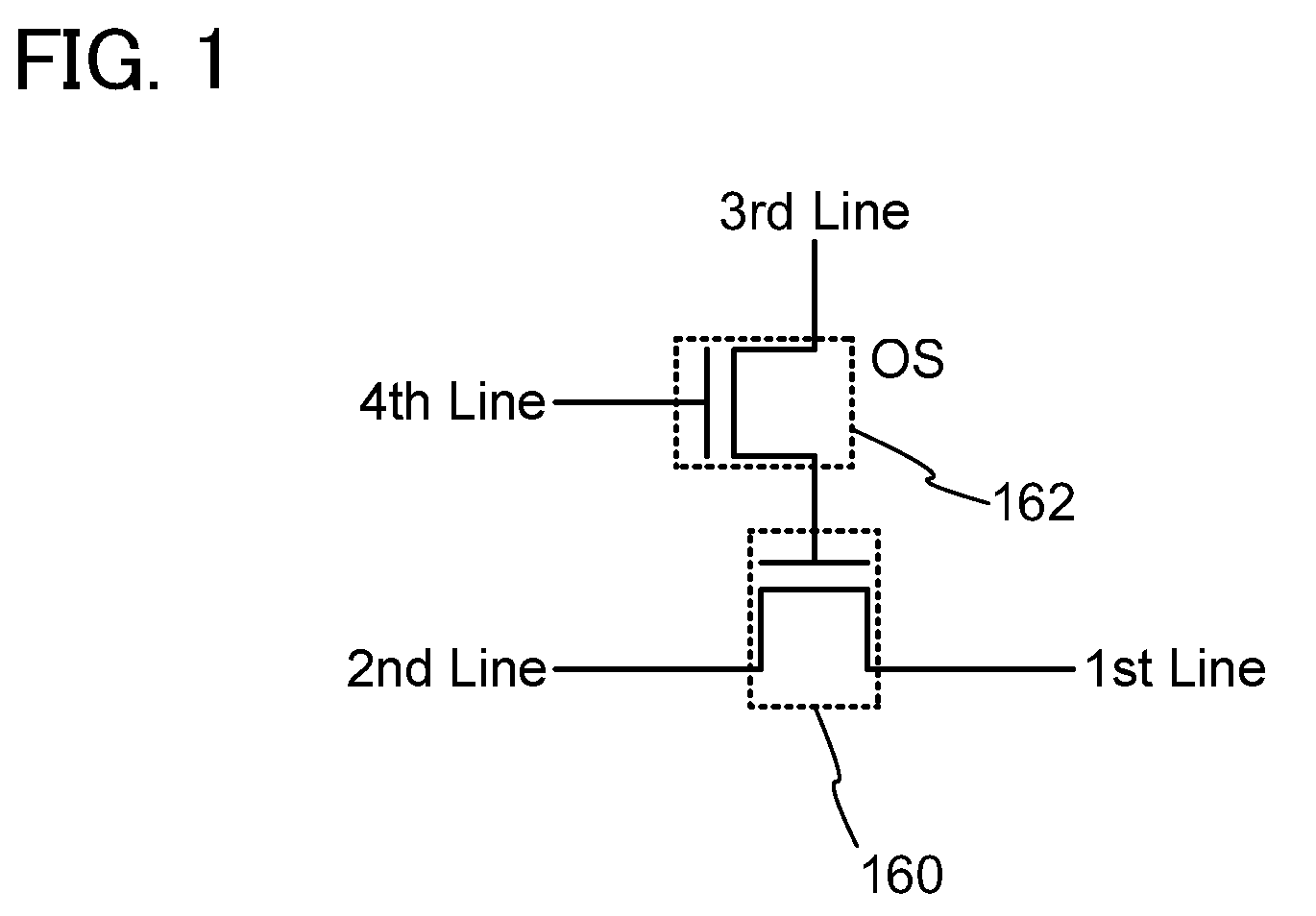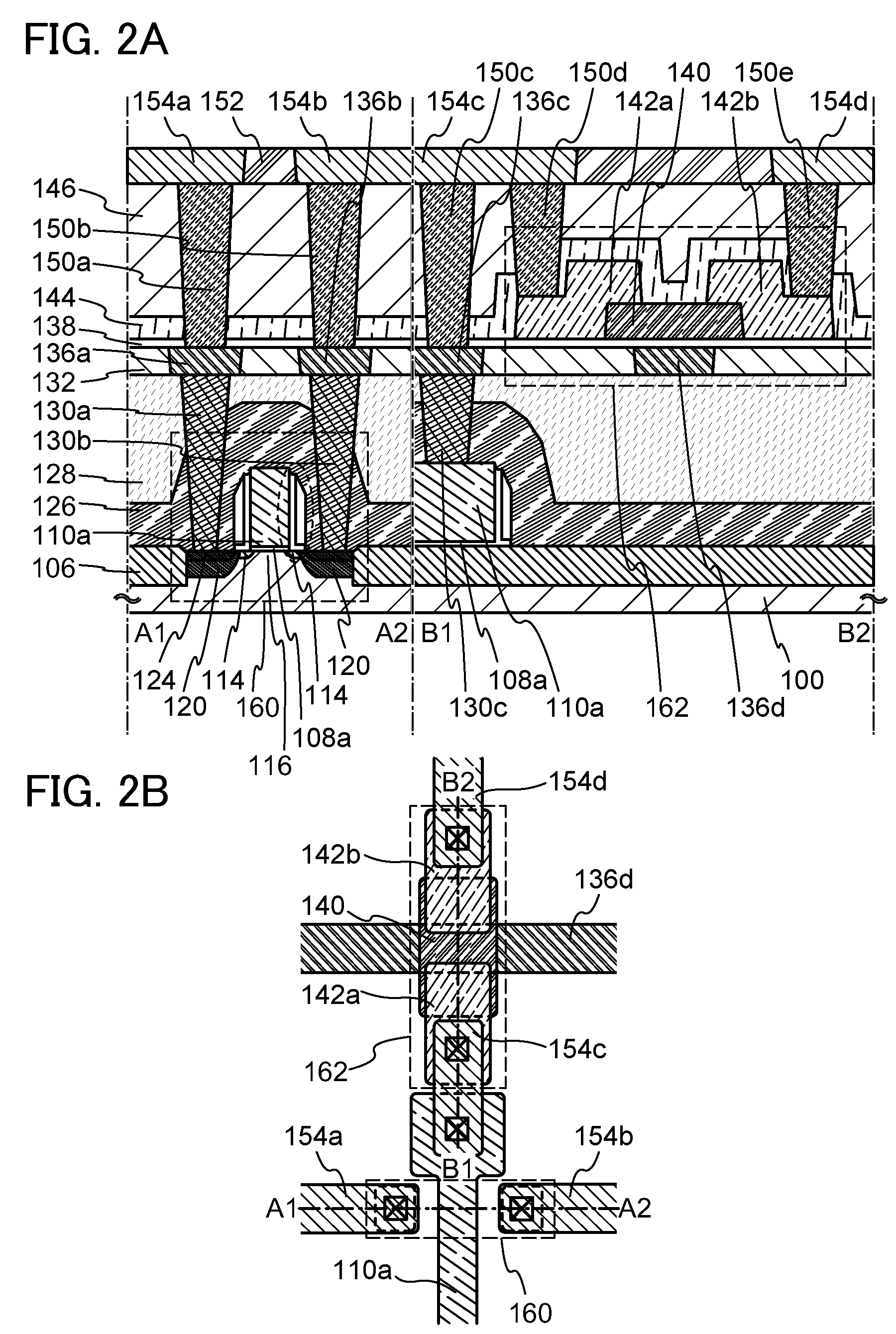Semiconductor device
a technology of semiconductors and semiconductors, applied in the field of semiconductor devices, can solve the problems of difficult to reduce power consumption satisfactorily, short data holding period, loss of memory content, etc., and achieve the effect of easy multi-value information
- Summary
- Abstract
- Description
- Claims
- Application Information
AI Technical Summary
Benefits of technology
Problems solved by technology
Method used
Image
Examples
embodiment 1
[0077]In this embodiment, structures and manufacturing methods of semiconductor devices according to one embodiment of the disclosed invention are described with reference to FIG. 1, FIGS. 2A and 2B, FIGS. 3A to 3H, FIGS. 4A to 4G, FIGS. 5A to 5D, FIG. 6, FIGS. 7A and 7B, FIGS. 8A and 8B, FIG. 9, FIG. 10, FIG. 11, FIG. 12, FIGS. 13A and 13B, FIGS. 14A and 14B, and FIGS. 15A and 15B.
[0078]FIG. 1 illustrates an example of a circuit configuration of a semiconductor device. The semiconductor device includes a transistor 160 which uses a material other than an oxide semiconductor and a transistor 162 which uses an oxide semiconductor. Note that a mark “OS” is added to the transistor 162 in FIG. 1 to show that the transistor 162 uses an oxide semiconductor.
[0079]Here, a gate electrode of the transistor 160 is electrically connected to one of a source electrode and a drain electrode of the transistor 162. A first wiring (which is denoted as “1st Line” and also called a source line) and a s...
embodiment 2
[0234]In this embodiment, a circuit configuration and operation of a semiconductor device according to one embodiment of the present invention will be described.
[0235]An example of a circuit diagram of a memory element (hereinafter also referred to as a memory cell) including the semiconductor device is illustrated in FIG. 16. A memory cell 200 illustrated in FIG. 16 is a multi-valued memory cell and includes a source line SL, a bit line BL, a first signal line S1, a second signal line S2, a word line WL, a transistor 201, a transistor 202, a transistor 203, and a capacitor 205. The transistors 201 and 203 are formed using a material other than an oxide semiconductor, and the transistor 202 is formed using an oxide semiconductor.
[0236]Here, a gate electrode of the transistor 201 is electrically connected to one of a source electrode and a drain electrode of the transistor 202. In addition, the source line SL is electrically connected to a source electrode of the transistor 201, and ...
embodiment 3
[0283]In this embodiment, a circuit configuration and operation of a semiconductor device according to one embodiment of the present invention are described.
[0284]In this embodiment, a reading operation different from that of Embodiment 2 is described with the use of a circuit configuration of a memory element illustrated in FIG. 16. Note that the capacitor 205 shown in FIG. 16 is not always necessary and can be omitted in some cases. The memory element considered is a multivalued memory element, and a case where the memory element is a four-valued memory element is described in this embodiment. Four states of a memory cell 200 are data “00b”, “01b”, “10b”, and “11b”, and corresponding potentials of a node A are V00, V01, V10, and V11 (V00011011), respectively.
[0285]When writing is performed to the memory cell 200, the source line SL is set to 0 [V], the word line WL is set to 0 [V], the bit line BL is set to 0 [V], and the second signal line S2 is set to 2 [V]. When the data “00b” ...
PUM
 Login to View More
Login to View More Abstract
Description
Claims
Application Information
 Login to View More
Login to View More - R&D
- Intellectual Property
- Life Sciences
- Materials
- Tech Scout
- Unparalleled Data Quality
- Higher Quality Content
- 60% Fewer Hallucinations
Browse by: Latest US Patents, China's latest patents, Technical Efficacy Thesaurus, Application Domain, Technology Topic, Popular Technical Reports.
© 2025 PatSnap. All rights reserved.Legal|Privacy policy|Modern Slavery Act Transparency Statement|Sitemap|About US| Contact US: help@patsnap.com



